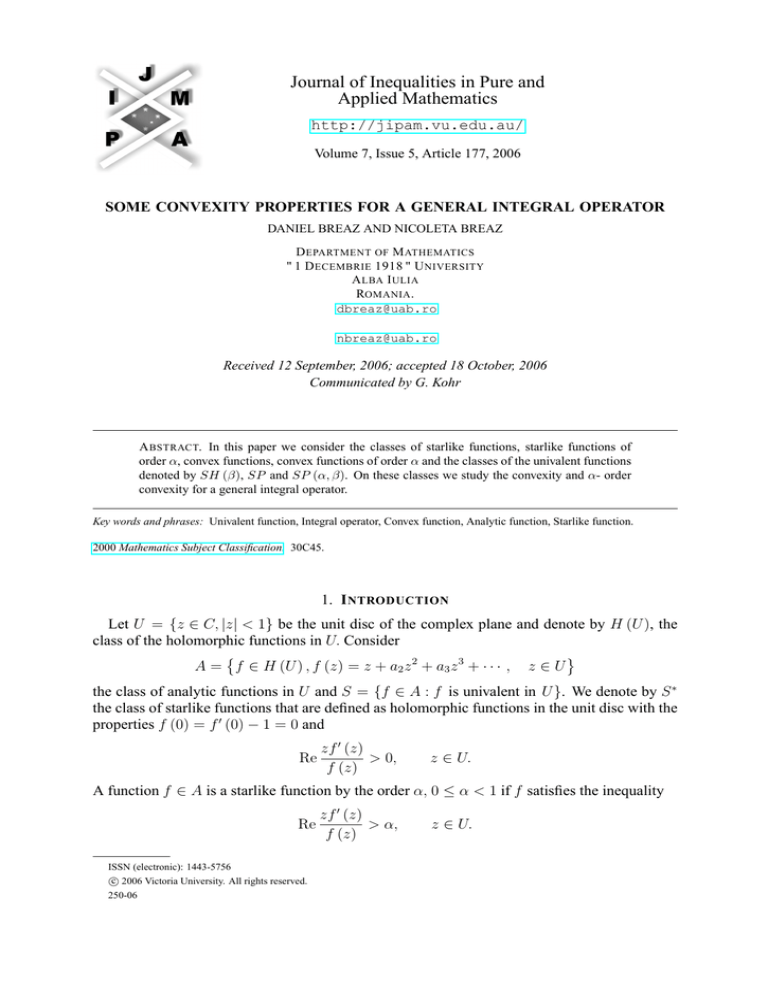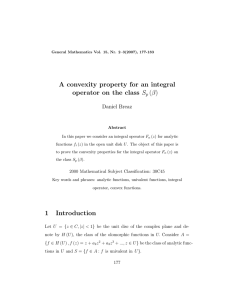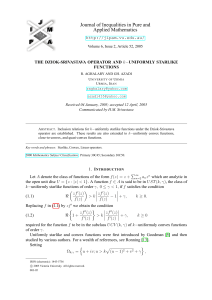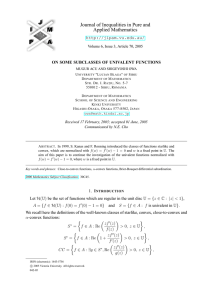
Journal of Inequalities in Pure and
Applied Mathematics
http://jipam.vu.edu.au/
Volume 7, Issue 5, Article 177, 2006
SOME CONVEXITY PROPERTIES FOR A GENERAL INTEGRAL OPERATOR
DANIEL BREAZ AND NICOLETA BREAZ
D EPARTMENT OF M ATHEMATICS
" 1 D ECEMBRIE 1918 " U NIVERSITY
A LBA I ULIA
ROMANIA .
dbreaz@uab.ro
nbreaz@uab.ro
Received 12 September, 2006; accepted 18 October, 2006
Communicated by G. Kohr
A BSTRACT. In this paper we consider the classes of starlike functions, starlike functions of
order α, convex functions, convex functions of order α and the classes of the univalent functions
denoted by SH (β), SP and SP (α, β). On these classes we study the convexity and α- order
convexity for a general integral operator.
Key words and phrases: Univalent function, Integral operator, Convex function, Analytic function, Starlike function.
2000 Mathematics Subject Classification. 30C45.
1. I NTRODUCTION
Let U = {z ∈ C, |z| < 1} be the unit disc of the complex plane and denote by H (U ), the
class of the holomorphic functions in U. Consider
A = f ∈ H (U ) , f (z) = z + a2 z 2 + a3 z 3 + · · · , z ∈ U
the class of analytic functions in U and S = {f ∈ A : f is univalent in U }. We denote by S ∗
the class of starlike functions that are defined as holomorphic functions in the unit disc with the
properties f (0) = f 0 (0) − 1 = 0 and
Re
zf 0 (z)
> 0,
f (z)
z ∈ U.
A function f ∈ A is a starlike function by the order α, 0 ≤ α < 1 if f satisfies the inequality
Re
ISSN (electronic): 1443-5756
c 2006 Victoria University. All rights reserved.
250-06
zf 0 (z)
> α,
f (z)
z ∈ U.
2
DANIEL B REAZ AND N ICOLETA B REAZ
We denote this class by S ∗ (α). Also, we denote by K the class of convex functions that are
defined as holomorphic functions in the unit disc with the properties f (0) = f 0 (0) − 1 = 0 and
00
zf (z)
Re
+ 1 > 0,
z ∈ U.
f 0 (z)
A function f ∈ A is a convex function by the order α, 0 ≤ α < 1 if f verifies the inequality
00
zf (z)
+ 1 > α,
z ∈ U.
Re
f 0 (z)
We denote this class by K (α).
In the paper [5] J. Stankiewicz and A. Wisniowska introduced the class of univalent functions,
SH (β), β > 0 defined by:
0
√
√
√ zf 0 (z)
zf (z)
(1.1)
2 − 1 < Re
2
+ 2β
2−1 ,
f ∈ S,
f (z) − 2β
f (z)
for all z ∈ U .
Also, in the paper [3] F. Ronning introduced the class of univalent functions, SP , defined by
zf 0 (z) zf 0 (z)
(1.2)
Re
>
− 1 ,
f ∈ S,
f (z)
f (z)
for all z ∈ U . The geometric interpretation of the relation (1.2) is that the class SP is the class
of all functions f ∈ S for which the expression zf 0 (z) /f (z) , z ∈ U takes all values in the
parabolic region
Ω = {ω : |ω − 1| ≤ Re ω} = ω = u + iv : v 2 ≤ 2u − 1 .
In the paper [3] F. Ronning introduced the class of univalent functions SP (α, β) , α > 0,
β ∈ [0, 1), as the class of all functions f ∈ S which have the property:
0
0
zf (z)
≤ Re zf (z) + α − β,
(1.3)
−
(α
+
β)
f (z)
f (z)
for all z ∈ U . Geometric interpretation: f ∈ SP (α, β) if and only if zf 0 (z) /f (z) , z ∈ U
takes all values in the parabolic region
Ωα,β = {ω : |ω − (α + β)| ≤ Re ω + α − β}
= ω = u + iv : v 2 ≤ 4α (u − β) .
We consider the integral operator Fn , defined by:
α
α
Z z
f1 (t) 1
fn (t) n
(1.4)
Fn (z) =
· ··· ·
dt
t
t
0
and we study its properties.
Remark 1.1.RWe observe that for n = 1 and α1 = 1 we obtain the integral operator of Alexanz
der, F (z) = 0 f (t)
dt.
t
J. Inequal. Pure and Appl. Math., 7(5) Art. 177, 2006
http://jipam.vu.edu.au/
C ONVEXITY P ROPERTIES FOR A G ENERAL I NTEGRAL O PERATOR
3
2. M AIN R ESULTS
Theorem 2.1. Let αi , i ∈ {1, . . . , n} be real numbers with the properties αi > 0 for i ∈
{1, . . . , n} and
n
X
αi ≤ n + 1.
i=1
We suppose that the functions fi , i = {1, . . . , n} are the starlike functions by order α1i , i ∈
{1, . . . , n}, that is fi ∈ S ∗ α1i for all i ∈ {1, . . . , n} . In these conditions the integral operator
defined in (1.4) is convex.
Proof. We calculate for Fn the derivatives of the first and second order. From (1.4) we obtain:
α
α
f1 (z) 1
fn (z) n
0
Fn (z) =
· ··· ·
z
z
and
Fn00
(z) =
n
X
αi
i=1
fi (z)
z
αi −1 zfi0 (z) − fi (z)
zfi (z)
Y
n j=1
fj (z)
z
α j
.
j6=i
Fn00 (z)
Fn0 (z)
(2.1)
zf10
zfn0
(z) − f1 (z)
(z) − fn (z)
= α1
+ · · · + αn
zf1 (z)
zfn (z)
0
0
Fn00 (z)
f1 (z) 1
fn (z) 1
= α1
−
+ · · · + αn
−
.
Fn0 (z)
f1 (z) z
fn (z) z
,
By multiplying the relation (2.1) with z we obtain:
0
X
n
n
zFn00 (z) X
zfi (z)
zfi0 (z)
=
α
−
1
=
α
− α1 − · · · − αn .
(2.2)
i
i
Fn0 (z)
f
(z)
f
(z)
i
i
i=1
i=1
The relation (2.2) is equivalent with
(2.3)
zf10 (z)
zfn0 (z)
zFn00 (z)
+ 1 = α1
+ · · · + αn
− α1 − · · · − αn + 1.
Fn0 (z)
f1 (z)
fn (z)
From (2.3) we obtain that:
00
zFn (z)
zf10 (z)
zfn0 (z)
(2.4)
Re
+
1
=
α
Re
+
·
·
·
+
α
Re
− α1 − · · · − αn + 1.
1
n
Fn0 (z)
f1 (z)
fn (z)
zf 0 (z)
∗
But fi ∈ S α1i , for all i ∈ {1, . . . , n} , so Re fii(z) > α1i , for all i ∈ {1, . . . , n} . We apply
this affirmation in the equality (2.4) and obtain:
00
zFn (z)
1
1
(2.5)
Re
+ 1 > α1 + · · · + αn
− α1 − · · · − αn + 1
0
Fn (z)
α1
αn
n
X
=n+1−
αi .
i=1
But, in accordance with the hypothesis, we obtain:
00
zFn (z)
Re
+1 >0
Fn0 (z)
so, Fn is a convex function.
J. Inequal. Pure and Appl. Math., 7(5) Art. 177, 2006
http://jipam.vu.edu.au/
4
DANIEL B REAZ AND N ICOLETA B REAZ
Theorem 2.2. Let αi , i ∈ {1, . . . , n}, be real numbers with the properties αi > 0 for i ∈
{1, . . . , n} and
n
X
αi ≤ 1.
i=1
We suppose that the functions fi , i = {1, . . . , n},
Pare the starlike functions. Then the integral
operator defined in (1.4) is convex by order, 1 − ni=1 αi .
Proof. Following the same steps as in Theorem 2.1, we obtain:
0
X
n
n
zFn00 (z) X
zfi (z)
zfi0 (z)
(2.6)
=
α
−
1
=
α
− α1 − · · · − αn .
i
i
Fn0 (z)
f
(z)
f
(z)
i
i
i=1
i=1
The relation (2.6) is equivalent with
(2.7)
zFn00 (z)
zf10 (z)
zfn0 (z)
+
1
=
α
+
·
·
·
+
α
− α1 − · · · − αn + 1.
1
n
Fn0 (z)
f1 (z)
fn (z)
From (2.7) we obtain that:
00
zFn (z)
zf10 (z)
zfn0 (z)
(2.8)
Re
+
1
=
α
Re
+
·
·
·
+
α
Re
− α1 − · · · − αn + 1.
1
n
Fn0 (z)
f1 (z)
fn (z)
zf 0 (z)
But fi ∈ S ∗ for all i ∈ {1, . . . , n} , so Re fii(z) > 0 for all i ∈ {1, . . . , n} . We apply this
affirmation in the equality (2.8) and obtain that:
00
n
X
zFn (z)
(2.9)
Re
+ 1 > α1 · 0 + · · · + αn · 0 − α1 − · · · − αn + 1 = 1 −
αi .
Fn0 (z)
i=1
But in accordance with the inequality (2.9), obtain that
00
n
X
zFn (z)
Re
+1 >1−
αi
Fn0 (z)
i=1
P
so, Fn is a convex function by order 1 − ni=1 αi .
Theorem 2.3. Let αi , i ∈ {1, . . . , n}, be real numbers with the properties αi > 0, for i ∈
{1, . . . , n} and
√
n
X
2
√
√ .
(2.10)
αi ≤
2β
2−1 + 2
i=1
We suppose that fi ∈ SH (β), for i = {1, . . . , n} and β > 0. In these conditions, the integral
operator defined in (1.4) is convex.
Proof. Following the same steps as in Theorem 2.1, we obtain that:
n
n
X
zFn00 (z)
zfi0 (z) X
(2.11)
+1=
αi
−
αi + 1.
Fn0 (z)
fi (z)
i=1
i=1
√
We multiply the relation (2.11) with 2 and obtain:
X
n
n
√ zFn00 (z)
√ zfi0 (z) √ X
√
(2.12)
2
+
1
=
2α
−
2
α
+
2.
i
i
Fn0 (z)
fi (z)
i=1
i=1
J. Inequal. Pure and Appl. Math., 7(5) Art. 177, 2006
http://jipam.vu.edu.au/
C ONVEXITY P ROPERTIES FOR A G ENERAL I NTEGRAL O PERATOR
5
The equality (2.12) is equivalent with:
√
2
X
n √
√ zfi0 (z)
zFn00 (z)
2−1
+1 =
αi 2
+ 2αi β
Fn0 (z)
fi (z)
i=1
n
n
√
√ X
X
√
−
2αi β
2−1 − 2
αi + 2.
i=1
i=1
We calculate the real part from both terms of the above equality and obtain:
√
2 Re
X
n √
√ zfi0 (z)
zFn00 (z)
+1 =
αi Re
2
+ 2β
2−1
Fn0 (z)
f
(z)
i
i=1
n
n
√
√ X
X
√
−
2αi β
2−1 − 2
αi + 2.
i=1
i=1
Because fi ∈ SH (β) for i = {1, . . . , n}, we apply in the above relation the inequality (1.1)
and obtain:
0
00
X
n
√
√
zfi (z)
zFn (z)
2 Re
+1 >
αi − 2β
2 − 1 Fn0 (z)
f
(z)
i
i=1
n
n
√ X
√
X
√
−
2αi β
2−1 − 2
αi + 2.
i=1
i=1
0
√
zf (z)
Because αi fii(z) − 2β
2 − 1 > 0, for all i ∈ {1, . . . , n}, we obtain that
(2.13)
√
2 Re
n
n
√
√ X
X
√
zFn00 (z)
+
1
>
−
2α
β
2
−
1
−
2
α
+
2.
i
i
Fn0 (z)
i=1
i=1
Using the hypothesis (2.10), we have:
(2.14)
Re
zFn00 (z)
+ 1 > 0,
Fn0 (z)
so, Fn is a convex function.
√
Corollary 2.4. Let α be real numbers with the properties 0 < α ≤
√ 2
√ ,
2β ( 2−1)+ 2
β > 0. We
suppose that the functions f ∈ SH (β). In these conditions the integral operator, F (z) =
R z f (t) α
dt is convex.
t
0
Proof. In Theorem 2.3, we consider n = 1, α1 = α and f1 = f .
Theorem 2.5. Let αi , i ∈ {1, . . . , n} be real numbers with the properties αi > 0 for i ∈
{1, . . . , n},
(2.15)
n
X
αi < 1
i=1
P
and 1 − ni=1 αi ∈ [0, 1). We consider the functions fi , fi ∈ SP P
for i = {1, . . . , n}. In these
conditions, the integral operator defined in (1.4) is convex by 1 − ni=1 αi order.
J. Inequal. Pure and Appl. Math., 7(5) Art. 177, 2006
http://jipam.vu.edu.au/
6
DANIEL B REAZ AND N ICOLETA B REAZ
Proof. Following the same steps as in Theorem 2.1, we have:
n
n
X zf 0 (z) X
zFn00 (z)
+1=
αi i
−
αi + 1.
0
Fn (z)
fi (z)
i=1
i=1
(2.16)
We calculate the real part from both terms of the above equality and obtain:
X
0
X
00
n
n
zFn (z)
zfi (z)
(2.17)
Re
+1 =
αi Re
−
αi + 1.
Fn0 (z)
fi (z)
i=1
i=1
Because fi ∈ SP for i = {1, . . . , n} we apply in the above relation the inequality (1.2) and
obtain:
0
X
X
00
n
n
zfi (z)
zFn (z)
(2.18)
Re
+1 >
αi − 1 −
αi + 1.
Fn0 (z)
fi (z)
i=1
i=1
0
zfi (z)
Because αi fi (z) − 1 > 0, for all i ∈ {1, . . . , n}, we get
Re
(2.19)
n
X
zFn00 (z)
+1 >1−
αi .
Fn0 (z)
i=1
Using the hypothesis, we obtain that Fn is a convex function by 1 −
P
Remark 2.6. If ni=1 αi = 1 then
00
zFn (z)
+ 1 > 0,
(2.20)
Re
Fn0 (z)
Pn
i=1
αi order.
so, Fn is a convex function.
Corollary 2.7. Let γ be a real number with the property
0 < γ < 1. We suppose that f ∈ SP .
R z f (t) γ
In these conditions the integral operator F (z) = 0
dt is convex of 1 − γ order.
t
Proof. In Theorem 2.5, we consider n = 1, α1 = γ and f1 = f .
Theorem 2.8. We suppose that f ∈ SP . In this condition, the integral operator of Alexander,
defined by
Z z
f (t)
(2.21)
F1 (z) =
dt,
t
0
is convex.
Proof. We have:
(2.22)
Re
zF100 (z)
zf 0 (z) zf 0 (z)
+ 1 = Re
>
− 1 > 0.
0
F1 (z)
f (z)
f (z)
So, the relation (2.22) implies that the Alexander operator is convex.
Remark 2.9. Theorem 2.8 can be obtained from Corollary 2.7, for γ = 1.
Theorem 2.10. Let αi , i ∈ {1, . . . , n} be real numbers with the properties αi > 0 for i ∈
{1, . . . , n},
(2.23)
n
X
i=1
αi <
1
,
α−β+1
J. Inequal. Pure and Appl. Math., 7(5) Art. 177, 2006
α > 0, β ∈ [0, 1)
http://jipam.vu.edu.au/
C ONVEXITY P ROPERTIES FOR A G ENERAL I NTEGRAL O PERATOR
7
P
and (β − α − 1) ni=1 αi + 1 ∈ (0, 1). We suppose that fi ∈ SP (α, β), for i =P
{1, . . . , n}.
In these conditions, the integral operator defined in (1.4) is convex by (β − α − 1) ni=1 αi + 1
order.
Proof. Following the same steps as in Theorem 2.1, we obtain that:
0
n
n
X
zFn00 (z) X
zfi (z)
(2.24)
=
α
+
α
−
β
+
(β
−
α
−
1)
αi .
i
Fn0 (z)
f
(z)
i
i=1
i=1
and
n
(2.25)
X
zFn00 (z)
+
1
=
αi
Fn0 (z)
i=1
zfi0 (z)
+α−β
fi (z)
+ (β − α − 1)
n
X
αi + 1.
i=1
We calculate the real part from both terms of the above equality and get:
( n
)
00
X zf 0 (z)
zFn (z)
i
(2.26)
Re
+ 1 = Re
αi
+α−β
Fn0 (z)
fi (z)
i=1
+ (β − α − 1)
n
X
αi + 1.
i=1
Because fi ∈ SP (α, β) for i = {1, . . . , n} we apply in the above relation the inequality (1.3)
and obtain:
0
00
X
n
n
X
zfi (z)
zFn (z)
+1 ≥
− (α + β) + (β − α − 1)
αi + 1.
(2.27)
Re
αi Fn0 (z)
fi (z)
i=1
i=1
0
zfi (z)
Since αi fi (z) − (α + β) > 0, for all i ∈ {1, . . . , n}, using the inequality (1.3), we have
00
n
X
zFn (z)
(2.28)
Re
+ 1 ≥ (β − α − 1)
αi + 1 > 0.
Fn0 (z)
i=1
Pn
From (2.28), since (β − α − 1) P
i=1 αi +1 ∈ (0, 1), we obtain that the integral operator defined
in (1.4) is convex by (β − α − 1) ni=1 αi + 1 order.
1
,
α−β+1
α > 0, β ∈ [0, 1). We
R z f (t) γ
suppose that f ∈ SP (α, β). In these conditions, the integral operator F (z) = 0
dt is
t
convex.
Corollary 2.11. Let γ be a real number with the property 0 < γ <
Proof. In Theorem 2.10, we consider n = 1, α1 = γ and f1 = f .
For α = β ∈ (0, 1) we obtain the class S (α, α) that is characterized by the property
0
zf (z)
zf 0 (z)
(2.29)
f (z) − 2α ≤ Re f (z) .
Corollary 2.12. Let αi , i ∈ {1, . . . , n} be real numbers with the properties αi > 0 for i ∈
{1, . . . , n} and
n
X
(2.30)
1−
αi ∈ [0, 1) .
i=1
We consider the functions fi , fi ∈ SP (α, α), i = {1,P
. . . , n}, α ∈ (0, 1). In these conditions,
the integral operator defined in (1.4) is convex by 1 − ni=1 αi order.
J. Inequal. Pure and Appl. Math., 7(5) Art. 177, 2006
http://jipam.vu.edu.au/
8
DANIEL B REAZ AND N ICOLETA B REAZ
Proof. From (1.4) we obtain
n
(2.31)
n
zFn00 (z) X zfi0 (z) X
=
αi
−
αi ,
Fn0 (z)
f
(z)
i
i=1
i=1
which is equivalent with
00
X
n
n
zFn (z)
zfi0 (z) X
(2.32)
Re
+
1
=
α
Re
−
αi + 1.
i
Fn0 (z)
f
(z)
i
i=1
i=1
From (2.31) and (2.32), we have:
0
X
00
n
n
X
zfi (z)
zFn (z)
(2.33)
Re
+1 >
αi − 2α + 1 −
αi .
Fn0 (z)
fi (z)
i=1
i=1
0
P
zf (z)
Since ni=1 αi fii(z) − 2α > 0, for all i ∈ {1, . . . , n}, from (2.33), we get:
00
n
X
zFn (z)
+
1
>
1
−
(2.34)
Re
αi .
Fn0 (z)
i=1
P
Now, from (2.34) we obtain that the operator defined in (1.4) is convex by 1− ni=1 αi order.
R EFERENCES
[1] M. ACU, Close to convex functions associated with some hyperbola, Libertas Mathematica, XXV
(2005), 109–114.
[2] D. BREAZ AND N. BREAZ, Two integral operators, Studia Universitatis Babeş -Bolyai, Mathematica, Cluj Napoca, (3) (2002), 13–21.
[3] F. RONNING, Integral reprezentations of bounded starlike functions, Ann. Polon. Math., LX(3)
(1995), 289–297.
[4] F. RONNING, Uniformly convex functions and a corresponding class of starlike functions, Proc.
Amer. Math. Soc., 118(1) (1993), 190–196.
[5] J. STANKIEWICZ AND A. WISNIOWSKA, Starlike functions associated with some hyperbola,
Folia Scientiarum Universitatis Tehnicae Resoviensis 147, Matematyka, 19 (1996), 117–126.
J. Inequal. Pure and Appl. Math., 7(5) Art. 177, 2006
http://jipam.vu.edu.au/




